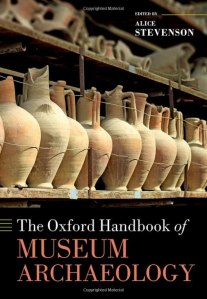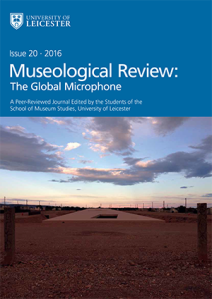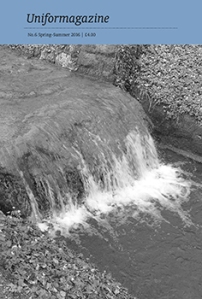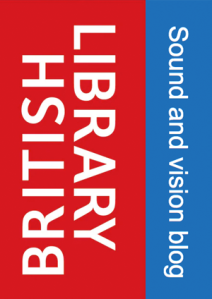Our museum’s publications, whether for external projects or via our own Museum of Portable Sound Press, discuss concepts relating to the collection, preservation, and exhibition of sounds as museum objects. Our Director and Chief Curator, Dr John Kannenberg, has been publishing writings on the culture of sound and its evolving place in museums for more than a decade.
External Publications
The Oxford Handbook of Museum Archaeology
Oxford University Press, 2022 • Edited by Alice Stevenson
Chapter 16: Listening to Archaeology Museums
by John Kannenberg
An introduction to the overall concepts related to sound and museums, and specifically to sound’s presence in archaeology museums. The chapter concludes with a brief survey of some of the sounds in the Archaeology Gallery at the Museum of Portable Sound.
Curator: The Museum Journal – Sonic Issue
Wiley, 2019 • Edited by Kathleen Wiens & Eric de Visscher
Soundmarks as Objects of Curatorial Care
by John Kannenberg
Abstract: In the 1991 book Exhibiting Cultures: The poetics and politics of museum display, Stephen Greenblatt introduced the concept of a museological ‘resonance’: the idea that objects on display within a museum exhibition ‘resonate’, or generate new meanings, via their relationships with the visitors who observe and interact with them. This paper explores how Greenblatt’s notion of museological resonance could be applied to the display of sounds themselves as cultural objects within a museum context. A mixtape or playlist-inspired approach to constructivist learning is proposed to re-imagine how sounds might be able to function within traditionally object-based museum exhibition. Soundmarks – sounds that reoccur within local communities which help to define their unique cultural identity – are presented as a potential area of research and collection by museums, while post-industrial soundmarks such as traffic signals for the visually impaired and the interface sounds of public transport systems are suggested as deserving of curatorial care via an expanded notion of intangible cultural heritage.
Science Museum Group Journal
Online Open Access, Science Museum, London, 2017
Towards a more sonically inclusive museum practice: a new definition of ’the ‘sound object
by John Kannenberg
Abstract: In this article, an overview of the multisensory roots of museum display and an exploration of the shifting definition of “object” leads to a discussion of Pierre Schaeffer’s musical term objet sonore – the “sound object”, which has traditionally stood for recorded sounds on magnetic tape used as source material for electroacoustic musical composition. A problematic term within sound studies, this article proposes a revised definition of “sound object”, shifting it from experimental music into the realm of the author’s own experimental curatorial practice of establishing The Museum of Portable Sound, an institution dedicated to the collection and display of sounds as cultural objects, to present a new working definition of the sound object as a museological (rather than a musical) concept.
‘Organising Sound’: how a research network might help structure an exhibition
by Tim Boon, Annie Jamieson, John Kannenberg, Aleks Kolkowski and James Mansell
Documents the 2015 Music, Noise and Silence workshops organised by the Science Museum, in partnership with the Royal College of Music and University of Nottingham, comprised three, two-day events, bringing together fifty-three researchers, writers, musicians and acousticians. The titular themes of music, noise and silence provided a theoretical framework for the workshop series and the sequence of the workshops may be seen as forming a crescendo from silence to noise.
Museological Review: The Global Microphone
University of Leicester, 2016
Listening to Museums: Sound mapping towards a sonically inclusive museology
by John Kannenberg
Abstract: What are some possible strategies for engaging with a museum soundscape? Could listening to museums lead to the development of a sonically inclusive museology? In my artistic practice, I make sound maps of museums including the Egyptian Museum in Cairo, the Art Institute of Chicago, Tate Modern in London, and The Pitt Rivers at Oxford. These sound maps are immersive audio tours juxtaposing sounds in new contexts like museum curators juxtapose objects in exhibitions. I also make blind listening sketches of museum soundscapes using an evolving lexicon of museum sound symbols. In this paper, I contextualise my museum sound mapping strategies within practices of sound arts and other mapping practices, and provide documentation of my results, including sound compositions and drawings that map my acts of listening to museum soundscapes.
Uniformagazine
Issue No. 6, Colin Sackett, Devon, UK, 2016
Why Listen to Museums?
by John Kannenberg
Text of a gallery talk given at the National Gallery, London, on 4 September 2015. Listen to an audio recording of the talk.
Sound and Vision Blog
The British Library, London, 2013
Listening to the Active Sounds of History: field recording and museums
by John Kannenberg
Excerpt: Memory is at the heart of much human activity. Memory drives us to collect, to record, to create documents –”information or evidence that serves as an official record” – that we then spend a lot of time and effort preserving. Some of these documents are strictly personal and kept as family heirlooms. Others end up being judged by someone else as having a broader significance, and end up being preserved in places like museums and libraries in order that they be made accessible to a wider audience. There are countless institutions around the world whose mission statements may not explicitly express it, but which are essentially dedicated to honoring the human desire to remember.
So why do I record sounds? Because I want to remember them.
Museum of Portable Sound Press
Gallery Guide (3 editions)
London & Southsea, 2016–2019
The guidebook used by our museum’s visitors has been revised twice so far, in the process becoming a 288 page, full colour introduction to a cross-disciplinary approach to the culture of sound. Features waveforms of every sound in the 30 galleries that constitute our Permanent Collection of Sounds, articles on the basics of sound and acoustics, a glossary of terms, dozens of close-up looks at the history of sound in culture, and much more.
The Museum of Portable Sound Adult Colouring-In Book
Southsea, 2020
Relax, learn, and create! The Museum of Portable Sound Adult Colouring-In Book tells a mini-history of portable sound technologies through a series of patent drawings suitable for colouring in. Includes drawings of the first transistor radio, the ‘Miami Vice’ mobile phone, the Walkman, the iPod, and much more – each drawing includes a descriptive object label, so you can learn while you colour. Plus there are waveforms of sounds in our Permanent Collection for you to test out your synaesthetic impulses upon!
Audio Tour: The 4′33″ Museum
by John Kannenberg
London, 2017
15 countries. 27 cities. 50 museums. Part guide book, part memoir, this book + 50-track digital audio box set documents a decades-long project recording museums around the world for four minutes and thirty three seconds, in reference to John Cage’s famous silent piece. Where Cage’s 4′33″ sought to put a conceptual frame around the act of listening, these recordings put a conceptual frame around the act of listening to places that put frames around artworks and other objects of culture.









